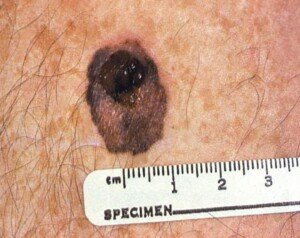
There are differences between melanomas that arise from existing moles and those that appear as brand new spots on skin where there’s no original mole.
• Melanomas from existing moles, upon diagnosis, tend to be thinner than melanomas that develop in the absence of a pre-existing mole, says the paper.
• Not surprisingly, tumors that come out of moles have a better prognosis.
Why are melanomas from pre-existing moles thinner?
The reason isn’t related to biology. It’s due to the relative ease at which a person can spot something suspicious.
When conducting self-exams, one’s tendency is to zero in on moles and note if there are any changes.
Skin areas without moles may get overlooked, or receive only a sweeping gaze, while moles get lots of attention and scrutiny.
Many people do not know that most melanomas occur in the absence of moles.
Their moles scare them more than other areas of skin. So they inspect them more. This leads to finding melanomas at earlier stages.

Shutterstock/pixinoo
These are the conclusions of a study in the Journal of the American Academy of Dermatology. The investigation was an analysis of 38 other studies involving 20,126 melanomas.
Because so many melanomas appear as a new growth rather than from a pre-existing mole, it’s crucial to familiarize yourself with all of your moles but also regularly examine new spots.

Melanoma. CDC, Carl Washington, MD, Emory Univ. School of Medicine, Mona Saraiya, MD, MPH
“While the numbers change study to study, I often tell patients about half the melanomas we see come from existing moles, while the other half appear on normal skin,” says Adam J. Mamelak, MD, a board certified dermatologist and founder of Sanova Dermatology in Austin, TX.
“While skin cancer does more commonly appear in sun exposed areas, the truth is it can appear anywhere on the skin — even where the sun doesn’t shine!” continues Dr. Mamelak.
“It can affect the soles of your feet, the top of your head and even the genital area.
“This is why I tell patients to get to know their skin. Every one to two months, check yourself out.
“Make sure all your moles are accounted for and no new ones have popped up.
“You can take a picture of a mole you might be concerned about with your cell phone.
“Set a reminder and compare the photo in a month to see if there are any changes.”
Even a crude drawing of your body parts with specks drawn in to indicate your moles can be highly valuable.
This way you’ll know that a new spot wasn’t there at the time you drew the map.

 Dr. Mamelak
Dr. Mamelak























